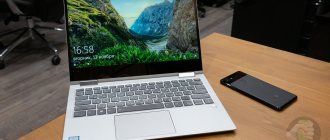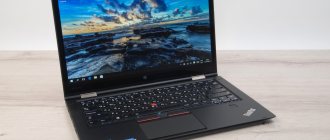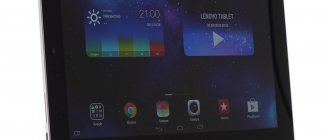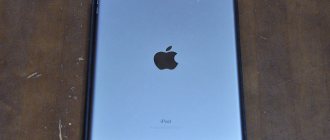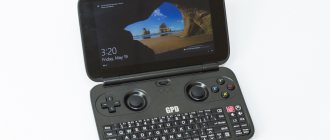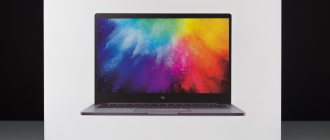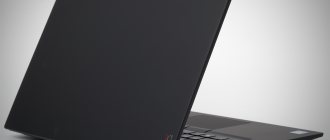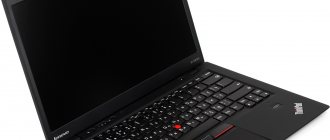In search of new formats, very unusual devices are created that impress any audience. But whether the experimental functions will take root in real life is impossible to answer at first glance. Today's guest, the Lenovo Yoga Book C930 , is a prime example of a gadget for the show. Judge for yourself: a compact laptop in a thin body is equipped with an electronic ink screen instead of a keyboard and opens by knocking on the lid. Let's figure out whether these chips are actually useful!
The best Telegram channel about technology (possibly)
Advantages:
- ergonomics of a thin transformer;
- second screen instead of keyboard;
- high-quality screen;
- 4G LTE support.
Flaws:
- modest performance of Intel Core m3;
- unclear positioning.
Appearance and ergonomics
The laptop is more similar in size and weight to large tablets and easily fits into small bags and miniature backpacks. All external panels are made of metal, light and strong, no complaints. But the device still requires careful handling. The test copy I received was not new; there are multiple scratches and chips on the cover.
At first glance at the Lenovo Yoga Book C930, it is completely unclear how it opens. When closed, the halves are securely held by magnets. Double knock on the lid, and the magnets snap off, opening the laptop slightly. All that remains is to open the hinge to the desired position. The feature looks impressive, but the sensors do not always work, only in 7-8 cases out of 10. Therefore, in real life it is much easier to press the volume down button to get the same result.
GIF animation available by clicking, full size 8.66 MB
The Lenovo proprietary hinge, which has long been used on other devices from the Yoga line, is responsible for opening the transformer. This is a very technologically advanced and beautiful mechanism consisting of many small parts. As a result, the cover is fixed in any of all possible positions. But there is still play: when actively typing texts, the lid shakes.
There are four main modes: laptop, tablet and two options for presentations or watching videos. Transformability goes well with compact dimensions; using all formats is really convenient. But compared to conventional tablets, holding the 775-gram Yoga Book with one hand is still a bit difficult.
conclusions
Yes, the Lenovo Yoga Book C930 is somewhat “shocking” - an E-Ink screen instead of the usual keyboard. Yes, this is somewhat “weak” - nevertheless, the filling is clearly not suitable for working in powerful applications. Yes, this is to some extent “over price” - 100 thousand rubles for a weak transformer is somehow a lot. Yes, this is to some extent “universal” - the Lenovo Yoga Book C930 still has significantly more options for use than a regular transformable ultrabook. So, who is this device for? Of course, for those who understand that the Lenovo Yoga Book C930 will truly give them the freedom to work that only this device can give. Still, this is truly an “all-in-one” device that allows you to replace a laptop, a tablet, a drawing tablet, an e-reader, etc. Also, this device will probably be in demand in the corporate environment, and will probably be purchased by large companies for top managers. One thing is clear - the Lenovo Yoga Book C930 is not a device for everyone, and not for everyone. Well, the most important question is why Lenovo created such a very interesting and unusual, but extremely specific device “not for everyone”? The answer may not be so obvious, but it is very simple - “because it can.” After all, if it weren’t for Lenovo, someone else would have come up with such a device.
Lutovinov Maxim (aka. Kok) 01/30/2020
Tags Lenovo Yoga Book C930 Lenovo Yoga Lenovo Yoga Book Lenovo ultrabook
Second screen for creativity
The Yoga Book C930 does not have a traditional physical keyboard. In its place is a touch screen with electronic ink. The diagonal is the same as the main one, the resolution is slightly lower. By default, the secondary display displays the keyboard and touchpad. In my opinion, the keyboard layout is awkward. Please note that a small toolbar occupies an entire line at the top. It would be worth moving it lower into the free space to increase the touchpad.
When you touch the keys, the vibration motor is activated. The company was counting on high-quality feedback, but the vibration does not give a clicking sensation, it only makes the case and the entire table hum. I think many users will prefer to disable the vibration response in principle, since such an option is provided.
The laptop is compact, so the sizes of all elements are appropriate. Coupled with unclear feedback, touch typing is inconvenient. By default, the touchpad is hidden and opens with a button, covering the space bar. This is exactly the mode activated in the photo below. Alternatively, all elements are displayed continuously and do not overlap each other. But the touchpad in this case is very small, and the lack of tactile edges does not allow them to be used blindly. During use, it is much more convenient to point your finger at the main screen or use a Bluetooth mouse.
Another mode is designed for drawing, the second display turns into a spacious canvas for handwritten notes. The idea is good, but the drawn lines are displayed with a noticeable delay - this is a feature of electronic ink. For some unknown reason, the stylus, being the key feature of the new product, is not included in the standard package. The pen needs to be looked for and purchased separately; this is inappropriate considering the cost of the gadget.
The third mode turns the additional E-Ink screen into a full-fledged e-reader. Books in PDF format are opened from the internal memory of the laptop. You cannot replace the built-in application with a third-party one, since it is impossible to display any windows on the second screen. On the one hand, the feature is interesting, on the other hand, a separate “reader” will be lighter and more functional.
Above the secondary display is a fingerprint scanner with an integrated LED power indicator. The quality of recognition and speed of operation are far from those of modern smartphones. During testing, it was much more convenient and faster to use a regular password.
High-quality main screen
As noted above, the main screen is 10.8-inch with an IPS matrix. The display is touch-sensitive, supports a stylus and is covered with glossy glass. There are thick frames around. This does not at all correspond to the modern fashion for bezel-less design, but it does contribute to a comfortable grip on the tablet. The resolution of 2560×1600 pixels is more than enough for such a diagonal; the image looks smooth even up close.
The high-quality matrix features full sRGB coverage, 82% NTSC and 86% AdobeRGB. Other indicators are not far behind; I was especially pleased with the contrast. But our copy is characterized by sloppy calibration out of the box; this issue can be solved with a colorimeter in 5 minutes.
Highlights on a dark background are invisible, but the colorimeter recorded discrepancies of up to 11.9 percent. The brightness range is sufficient: the upper level is 275.5 cd/m2, the lower level is 5.1 cd/m2.
The low final score on the DataColor scale is due to careless factory calibration.
Performance
The compact case and passive cooling affect the ability to install productive hardware. As a result, the Yoga Book C930 is powered by a 7-watt Intel Core m3-7Y30 with 2 cores and 4 threads, coupled with 4 GB of RAM. Built-in 128 GB SSD storage. This is enough to use the laptop as a typewriter, but no more. Even YouTube in the standard Edge browser has issues with smoothness and responsiveness. There is a slightly more advanced modification with Intel Core i5-7Y54 and 8 GB of memory. The processor is also 7-watt, so you shouldn’t expect a noticeable increase in performance.
The processor temperature does not exceed 70 degrees even under load. The monitoring shown in the screenshot was carried out while the tests were running. The heat is evenly distributed over the bottom cover, making it comfortable to hold the laptop in your hands.
Interfaces
There is one USB Type-C on both ends, there are no other connectors, none at all. This decision seems justified to me, since the Lenovo Yoga Book C930 is a modern thin and light laptop, the body of which has no place for bulky interfaces. Moreover, both connectors support charging via Power Delivery, image output via an adapter, and fast USB 3.1 flash drives. The power button and volume rocker are located at the end.
Optionally, the laptop supports LTE, the SIM card is installed in the usual tray. You can also insert microSD up to 512 GB to expand the internal storage.
Included is a 27 Watt charger with a Type-C connector. The laptop can also be charged from simple 10-watt adapters, so you can use any portable batteries. Such miniature adapters are usually included in smartphones.
What about in practice?
With performance, everything is clear - you can’t work in 3D modeling and design programs, but still the main purpose of the Lenovo Yoga Book C930 is working with the Internet, office applications and multimedia. Therefore, the first thing you pay attention to is the screen and autonomy. Yes, the main screen is very good - it has more than sufficient resolution for its diagonal, and yet it is an IPS matrix, and not a cheap TFT-TN, so watching videos and working with graphics brings extremely positive emotions. As for the battery, it lasts for an average of 4-7 hours of operation, depending on the usage scenario.
In fact, the Lenovo Yoga Book C930 is a versatile device with many use cases. The E-Ink keyboard adds additional capabilities to a regular ultrabook, but, however, at the expense of comfortable typing. Still, hitting painted keys is not at all the same as hitting physical ones. Yes, if you are fluent in touch typing, then there shouldn’t be any special problems. But still, in fact, the virtual keyboard is not as convenient as the physical one.
What is really convenient is the presence of Type-C connectors on both sides of the device. To any of them you can connect both peripherals and external devices, as well as a power supply for charging. Why don't almost any manufacturers do this? This is wildly convenient. Of course, one can complain about the complete absence of ordinary USB ports, but we don’t see this as a particular problem - today you can easily buy a USB flash drive with such a connector (for example, SanDisk Ultra USB Type-C), or a USB Hub with any desired set of ports and interfaces (such as, for example, Digma has - read our review), you can add an audio card, a network card with RJ45, HDMI video output, a card reader, or whatever. There’s nothing complicated - if you need additional ports, just connect the hub and you’re good to go.
By the way, Lenovo Yoga Book C930, in addition to the obvious wireless interfaces in the form of Wi-Fi (by the way, dual-band, with support for 5GHz networks) and Bluetooth (version 4.2), can also be equipped with an LTE module for independent access to the Internet. In principle, that’s all this device can boast of in terms of equipment. But what the Lenovo Yoga Book C930 definitely surprises with is its price.
Positioning
Initially, Lenovo Yoga Book C930 is intended for creative people who love to draw. A sort of hiking option in a compact body with good autonomy. The set of features corresponds to the positioning; there is a high-quality main screen and an active stylus. But upon closer acquaintance, the transformer rather disappoints. The company should seriously work on the proposed features, perhaps fit a full-fledged keyboard into the same thin body, and leave the stylus for the main matrix.
Lenovo Yoga Book C930 - what are you?
When you take an even thinner device out of a fairly thin box, you don’t expect any special catch. Well, yes, ultra-compact dimensions - only 180x260x10 mm (weight - 1.4 kg, but there are plenty of similar compact devices on the market. But surprises begin immediately at the beginning of the acquaintance - how to lift the lid? There are no protrusions, hooks, and the lid is securely fixed with magnets. Everything is quite prosaic - you need to knock on the lid twice, the mechanism will click, and the lid will tilt up slightly. True, the device does not always respond to tapping - you have to repeat until the result appears. And the lid will not open if the battery is completely discharged - but this right, because why open a laptop that won't turn on?
And so, we open the lid and one of the main features of the device appears to our eyes - two screens. The main one is 10-inch IPS with QHD resolution (2560x1600 pixels) and E-Ink with FullHD resolution (1920x1080 pixels), and both of them are touchscreen, which allows you to use the Lenovo Yoga Book C930 in a variety of ways - like a regular laptop , in this case, the keyboard is “drawn” on the E-Ink screen, like a tablet (“we simply slide the half” of the case with the keyboard behind the screen), like an e-reader (PDF files are displayed on the E-Ink screen), or like a drawing tablet ( You can draw on both displays, using a stylus, which will have to be purchased separately). And of course, it’s not a sin to use the device as a transformer - you can place the case in an L shape on the table, saving space and removing all unnecessary things (the keyboard) from your eyes.
Review after two weeks of use
Impressions from the Lenovo Yoga Book C930 are specific. On the one hand, the device leaves the impression of a well-assembled device made from quality materials. On the other hand, the proposed features do not find application in real life. This is a great device for creating a wow effect, an impressive demonstration of Lenovo's capabilities. In my case, throughout testing, the transformer was used as a multimedia tablet for watching movies and videos on YouTube. The ability to place the Yoga Book on a table without additional stands adds convenience.
Lenovo Yoga Book C930 specifications:
- Main display: 10.8 inches, aspect ratio 16:10, 2560×1600, IPS, 279 PPI, glossy glass, touch input, light sensor.
- Secondary display: 10.8-inch, 16:10 aspect ratio, 1920x1080, E Ink Mobius, frosted glass, touch input.
- Operating system: Windows 10 Home.
- Processor: Intel Core m3-7Y30.
- Graphics chip: Intel UHD Graphics 615.
- RAM: 4 GB LPDDR3.
- Built-in memory: 128 GB PCIe x2 NVMe.
- Wireless module: Intel Wireless-AC 8265 (Wi-Fi: 802.11ac, 2×2 MIMO; Bluetooth 4.1).
- Webcam: 2 MP without LED indicator, microphone.
- Ports and connectors: 2 × USB 3.1 (Gen 1) Type-C, microSD card reader, nanoSIM.
- Battery: non-removable, 4650 mAh.
- Dimensions: 179.4 × 260.4 × 9.9 mm.
- Weight: 775 grams.
Final score: 5 out of 10.
A controversial competitor to the Surface Laptop. Lenovo Yoga C930 laptop review
The Yoga line is one of the oldest, if not the oldest line of convertible laptops on the market. It has never been cheap, but has always been popular with users due to the price-quality ratio for truly optimal hardware and a beautiful design. Most recently, Lenovo introduced its continuation in the form of the C930 model, which should be a solution for all types of everyday tasks. Has Lenovo managed to create a machine that can replace several devices for you without losing face? Now we'll tell you.
Equipment and appearance
Apple is loved not only for its innovation and products, but also for its approach to design. Including packaging design. Everything is fine with this laptop. The box is made of beautiful and thick cardboard, and the elements and sections are beautifully divided with foam rubber and magnetic fasteners. The kit includes: a huge envelope with a small number of booklets and printing, USB Type-C charging, the laptop itself and... that's it. No additional accessories, stickers, etc. No, after the MacBook and Surface - this is a fairly typical situation, but you still expect something more in a laptop package for 198 thousand rubles.
The appearance of the device does not raise any questions. This is a stylish monolithic piece of metal, on the lid of which you can see the chrome lettering YOGA. The laptop is very light, only 1.3 kg, making it very convenient to carry in a small backpack or just take it with you. The keyboard looks a little strange, which is painted in the color of the case and is not highlighted in a separate color, but even this you quickly get used to. There is a small touchpad at the bottom, and to the right of it you can see a hole for the fingerprint scanner.
We are presented with a 13.9-inch diagonal screen with UltraHD resolution (3840×2160), which can be tilted and transformed into a tablet very simply and conveniently. By the way, Lenovo made sure that no one could peek through the webcam without permission. It closes here mechanically - with a lever. This function can be useful only to real paranoids, but let it be, why not? There is only one thing that doesn't please me: the frames. They are big here and spoil the entire experience of viewing the content. I just want to make them a little smaller so that more information can fit on the screen. At the bottom of the screen, on the transformer mechanism, there are Dolby Atmos speakers, the direction of the sound of which can be changed by rotating the screen.
But the best part here is the connectors. There are not very many of them, but this is compensated by their modernity. One fast USB 3.1 connector, a USB Type-C connector, a USB Type-C Thunderbolt connector, and a headphone jack.
For the appearance of the device you can give a solid four, it’s time to talk about the characteristics and experience of use.
Features and daily use
The laptop has a quad-core Intel Core i7-8550U processor, a 13.9-inch diagonal screen, 16 GB of DDR4 RAM, integrated Intel UHD Graphics 620, a 1 TB SSD drive, Bluetooth 4.1 (which made it difficult to install Bluetooth 5.0 in such an expensive laptop - it’s absolutely unclear), a fingerprint scanner and a stylus-pen built into the body.
As you would expect from such hardware, the laptop is very fast. The system boots almost instantly, applications open quickly. True, there was a fly in the ointment. The system is poorly optimized for the device. The sound periodically drops out, pen presses are not recognized, some applications do not open, and the image does not turn upside down in transformer mode. Typical Windows 10 errors that can be resolved by rebooting. A small thing, but very unpleasant. Especially when you need to work quickly.
In addition, we cannot fail to mention the disgusting fingerprint scanner. It almost never works. Any deviation from the surface almost 100% guarantees you a recognition error, and you can simply forget about using it in the heat. Sweaty fingers are an impassable barrier for the sensor. Again, it is not clear what prevented Lenovo from using eye or face recognition technology in such an expensive laptop, as competitors do, but the fact remains: the scanner here is bad and using it will not make your life easier. Quite the contrary.
The laptop opens all heavy programs perfectly. It will easily launch several Adobe applications, a browser, a player, a text editor - in general, everything you might need during the working day. But the laptop is absolutely not suitable for gaming. Due to the weak integrated graphics, the laptop cannot cope even with the latest games. If you wanted to play a game of Hearthstone or play Dota 2 for a few hours, forget it. This laptop is absolutely not for that.
Now let's stop at the screen. The screen here leaves mixed impressions. On the one hand, it is clear and bright, the viewing angles are at the highest level, watching movies or TV shows is a real pleasure, especially considering the sound. On the other hand, the screen has obvious problems with color calibration and saturation. When working with graphics in intense light, you will experience problems due to lack of contrast and color calibration. The problem is partially solved by adjusting the screen, but then the brightness becomes lower. It is unpleasant.
To be fair, if you want to use this laptop for non-professional image work, you won’t experience or feel any problems. By the way, it is worth mentioning that at the top of the screen next to the camera eye there is a special lever that allows you to close it and not use it. A real find for the paranoid!
Keyboard. She's good here. The key travel is just as fast typing requires. At first, the monochromatic color of the keys is annoying, but you can even get used to this. What is more annoying is the extremely uneven lighting. Some keys are backlit brightly, some dimly. This problem will not be relevant for those who know how to touch-type, but for those people who rely on backlighting, it will become a headache.
Autonomy. Everything is fine with her. With moderate use, without running heavy programs, the laptop lasts about 7-8 hours, which is a fairly good result. With active use, running several applications and setting the screen brightness to maximum, the device lasts about 3-4 hours. We can’t say that these are excellent results, but we wouldn’t dare call the laptop short-lived either.
Capabilities in tablet mode. Stylus pen
The main feature of the YOGA line has always been the rotating touch screen. And the sensor here is really good. It has a fast response to touches and works well in tablet mode. In addition, the laptop is very convenient to place in different positions for comfortable use. The only note: there are very few magnets to prevent the keyboard from wobbling when used in tablet mode. This does not cause any severe discomfort, but sometimes this option is sorely lacking.
Stylus. He's here more for show. Yes, you can use it to circle a couple of necessary phrases or take a screenshot, or at worst let your child draw, but it cannot be compared with a pen from Microsoft, and certainly not an Apple Pencil. It has a good response speed and is quite compact, but in this case this compactness plays against it. You don’t feel it with a pencil or pen in your hand; it acts precisely as a stylus. No more. You obviously won’t be able to draw masterpieces. But the very presence of it right in the case can be a definite plus. After all, it is sufficient for handwriting and small notes.
As a result, we have the following: a solid machine in a beautiful case with excellent hardware, a good keyboard and battery life, a very good screen and tablet mode. And one could turn a blind eye to the whole set of small jambs, if not for one thing: the price. She is unreasonably high. For this money, the laptop has a dozen competitors, including a MacBook in a not-so-budget configuration.
Looking at the price tag, you expect possibilities, but all you get is a compromise solution. If the price of the Yoga C930 were 40 thousand rubles lower, then this device would definitely be recommended for purchase, but for now... For now, the laptop looks extremely strange. Which does not detract from the fact that this is a very cool and expensive car.
